Osaka’s Kamagasaki district rarely makes the news, and when it did the other week, it was only because a film made to shed light on the area’s poverty was pulled at the last minute by the Osaka Asian Film Festival — the irony of which was clearly lost on the organisers. But, for Japan’s largest slum — the name of which doesn’t officially exist anymore — that’s presumably nothing new.
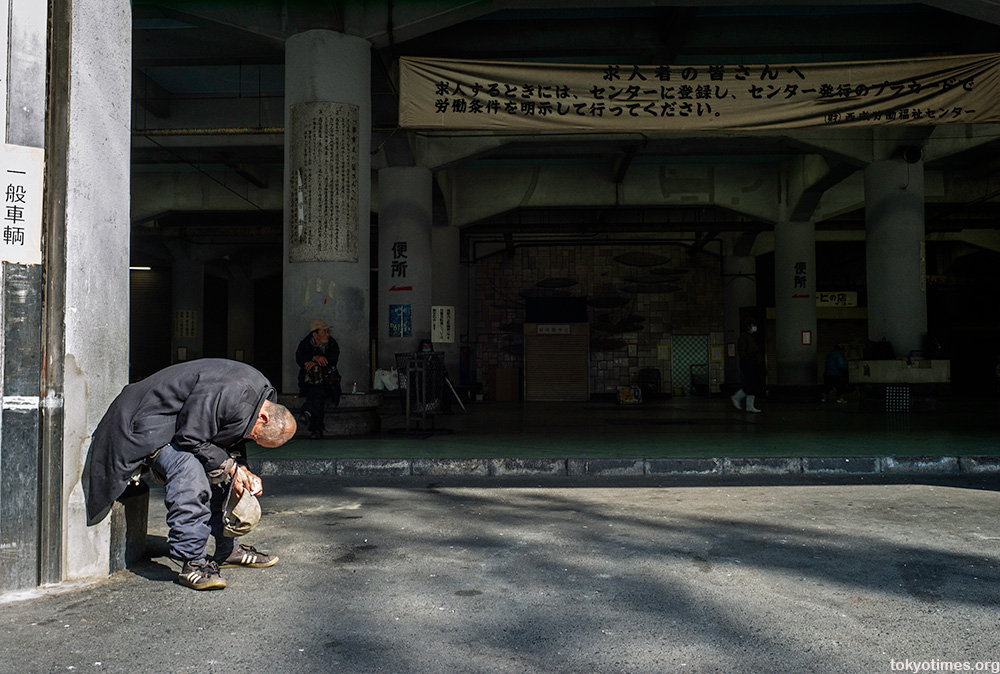
Home to approximately 25,000 people — absolutely dwarfing Tokyo’s equivalent, Sanya — the area is a far cry from the neon-lit, modern image of Japan’s sprawling urban centres. Although as a cruel reminder, Abenobashi Terminal Building, the country’s tallest, now looks down on the district and its residents with cold, unseeing eyes. Just like the city that sanctioned it. A nameless place, with faceless people.
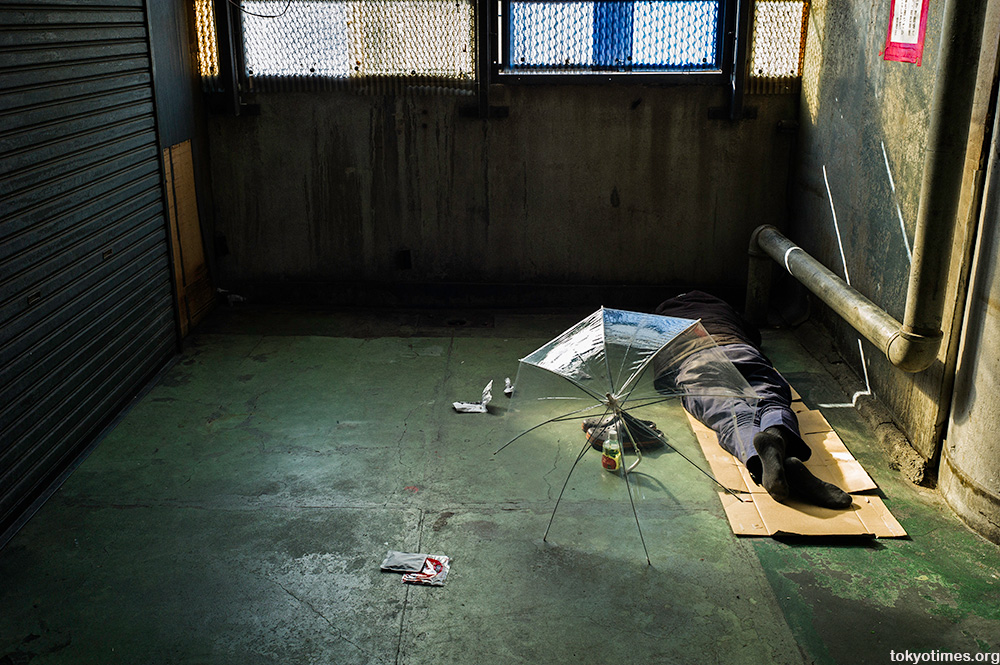
Ever since Japan’s post-war economic growth, and particularly the 1960s, Kamagasaki has been a destination for the poor to go in the hope of work as a day labourer. And as such, the Airin Labour and Welfare Centre is a key location and gathering point. A horribly unwelcoming building where increasingly older men sit and wait with all their worldly goods.
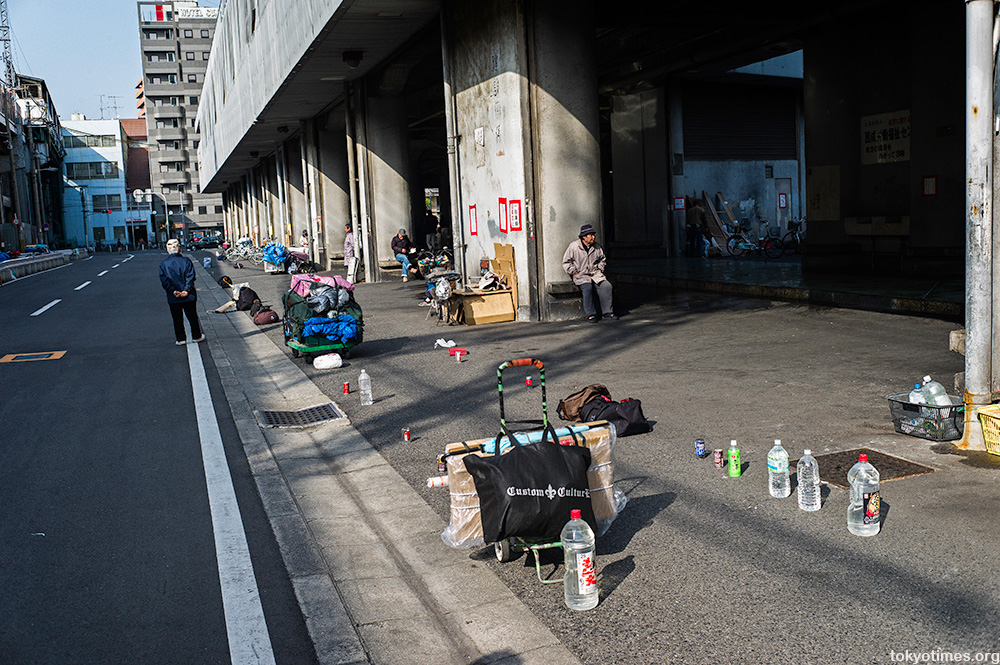
Each and every one of them patiently hoping the day will be a good one, and they’ll get some work.
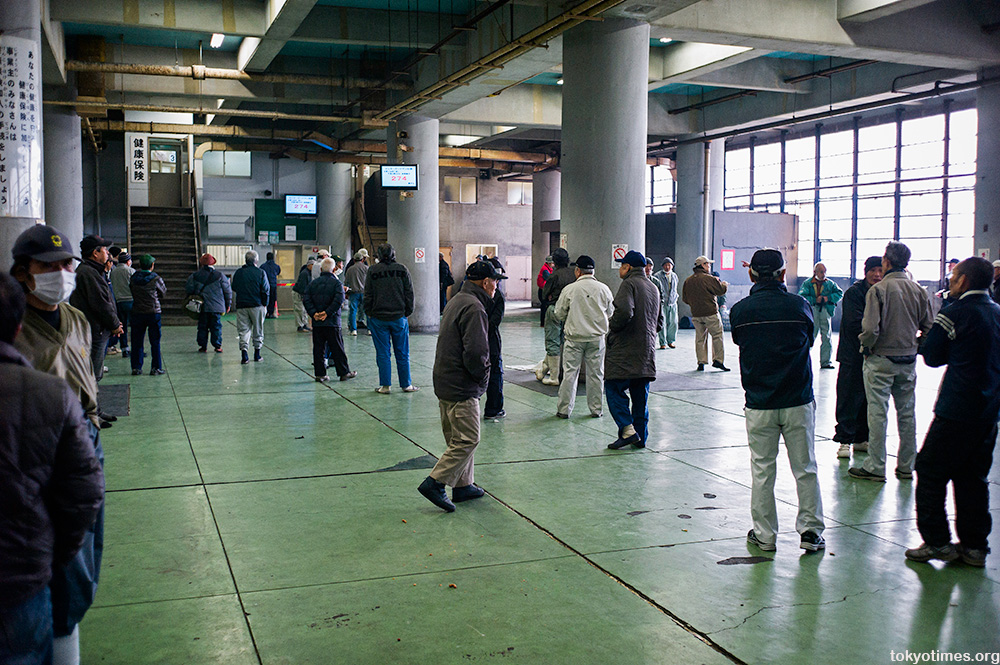
But at the same time, it’s a place filled with anything but hope. Just desperation and extreme poverty.
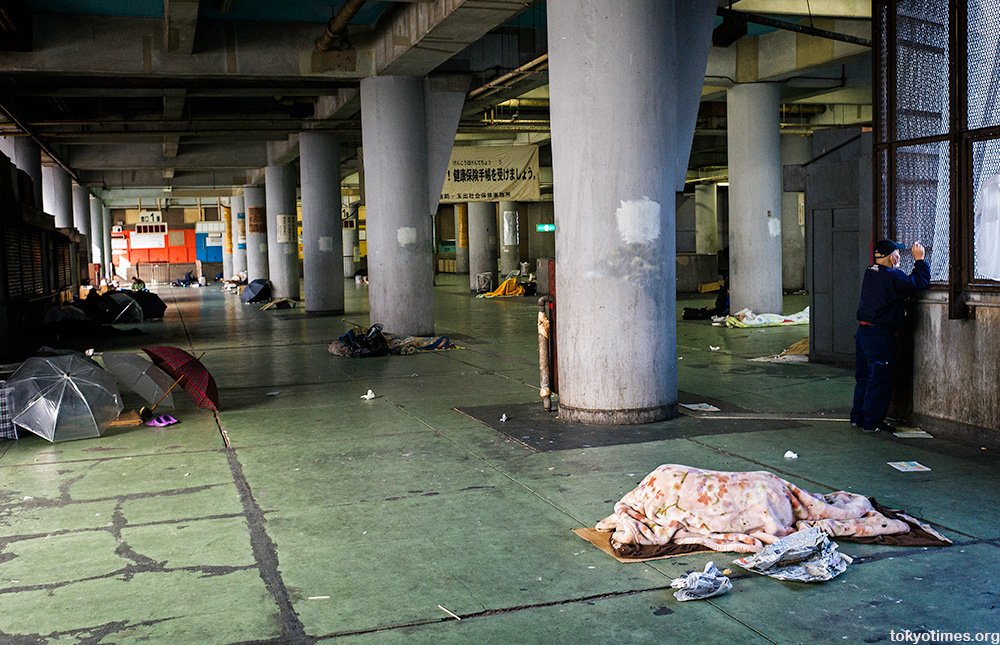
Kamagasaki’s other main hub, if one can call it that, is Sankaku Park. A small, triangular-shaped dust bowl surrounded by cheap, grotty accommodation.
The park’s focal point is a TV. Locked up and turned off most of the time, its viewers are restricted to brief morning and early evening viewings — the sumo, when we there, offering some much needed escape. Arguably the kind of social control that wouldn’t be out of place in an Orwellian nightmare, although in many ways that’s exactly what Kamagasaki is.
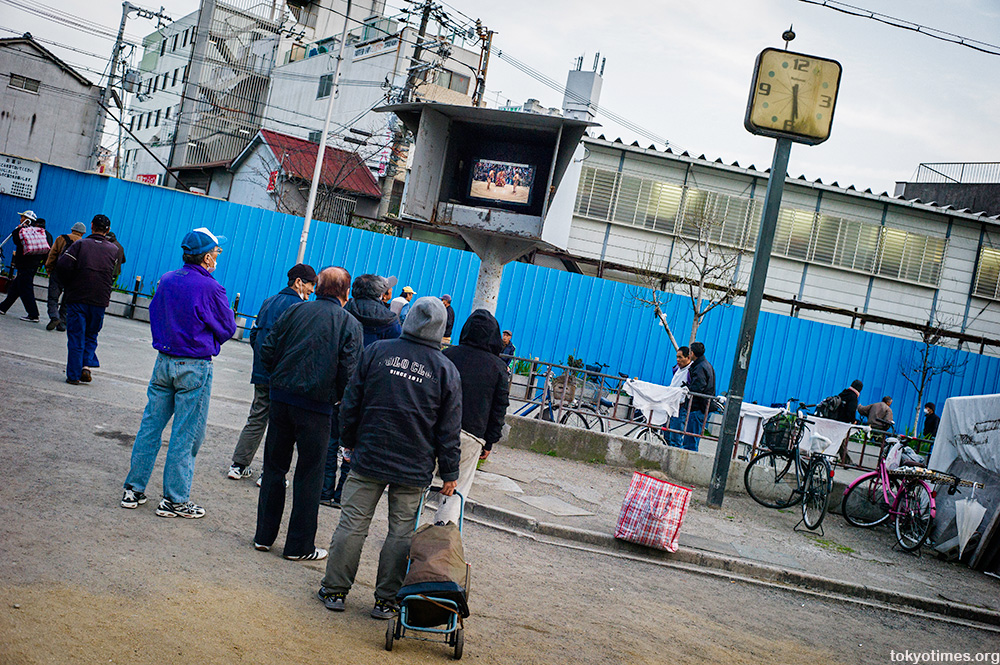
Apart from the TV, pretty much the only other escape is the ever-present booze, and the no doubt just as present, but not as visible, drugs.
Yet despite its horrendous poverty, and the shuffling, beaten nature of so many of the residents, Kamagasaki has a distinct sense of community, along with an openness rarely found in Japanese cities. People smiled. Talked. Even offered us just bought beer that a day’s work had mercifully supplied. And, most of all, seemed to look out for one-another.
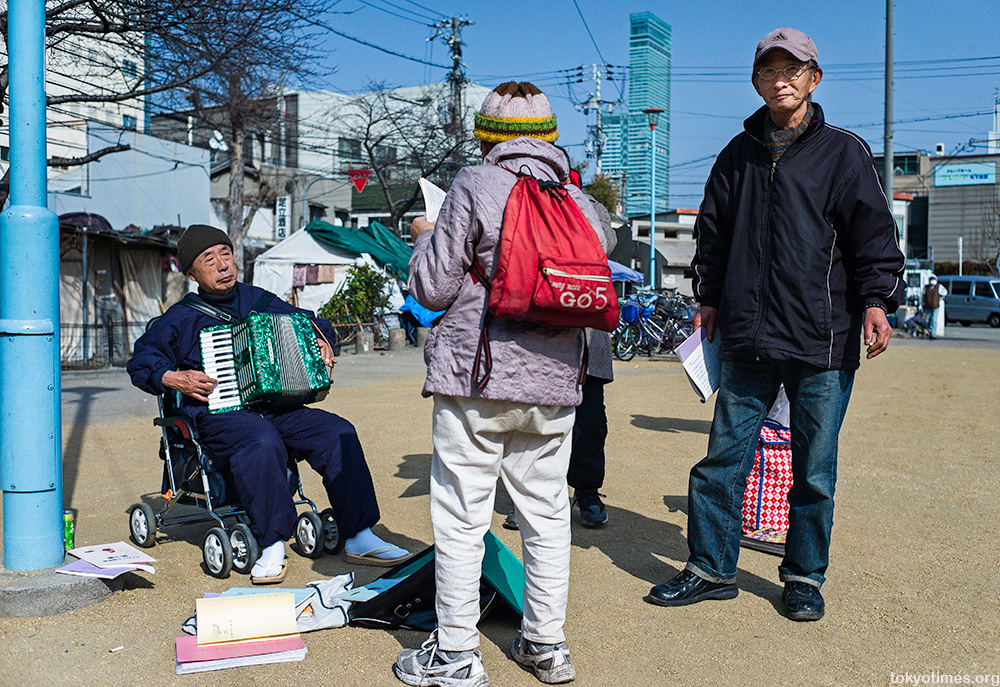
Colin McLaughlan says
Thank-you for taking the time to share this with us. I do love your blog and your amazing view of life in Japan. This however hits home and brings to me a sense that things are not that different from the “schemes” in Scotland where I grew up to the disposed I see in cites like San Francisco where I live now.
Lee says
Thank you very much.
No, in many ways they are not. It’s a side of Japan that is very rarely seen — by both Japanese and non-Japanese alike — but sadly it’s there. A problem that isn’t getting better either. Quite the opposite…
Geoff says
Wow, that’s pretty awful. Not my image of Japan at all…
Can’t say I enjoyed reading it, but it’s informative and good to know, so thank you.
Lee says
Glad you found it informative. It is a truly awful place. And definitely a long way from the usual images of Japan. But sadly just as much a part of Japan as cherry blossom and neon.
Chris says
Is that in Nishinari?
Lee says
It is, yes. The new name for it as I understand.
After visiting Sanya, Tokyo’s equivalent, on numerous occasions, I thought I was prepared for it, but I wasn’t. It’s just so vast, with so many people, in such sorry states. Mindboggling really in a city like Osaka…
Chris says
Oh I didn’t know that it had been renamed to Nishinari. When I lived in Osaka I went there a few times and yes it was drastically different from the rest of the country. It seems that Osaka has that area, and also a lot more under the bridge style communities as well in comparison to Tokyo.
Tyler says
What’s crazy is this is considered one of the worst areas in Japan, yet it looks like an average city in the US.
Hans ter Horst says
Good reporting, very shocking photos. It is definitely not the image Japan likes to show of itself but if you want to look, there are signs of the homeless problem in Japan everywhere. To me, the most shocking is the fact that my Japanese friends, usually very reasonable people, don’t appear to notice the homeless and when confronted, they brush it away by putting the blame on the homeless, it is all their own fault, and they leave it at that. The fact that the film got pulled from the Osaka Asian Film Festival is typical of the habit of taking away the human face of the problem to more easily ignore it.
Lee says
Thanks. It was a very shocking place. Very different from Sanya.
I know what you mean. Of course it happens all over the world, but there does seem to be very little sympathy here. And that, like you say, is if people even admit that there’s a problem in the first place. The most common response I get is some variation of, ‘the y choose to live like that. It’s an easy life. No work. No stress.’ But how anyone can honestly suggest that these (predominantly) men have happily chose that life is beyond me. It really is…
kate says
Im only 12 and I love everything about Japan. This was very shocking for me
Jerome says
Very nice pics ! I like to go in such places also, it bring me back to reality and real people. In term of poverty, I have always felt that Japan’s poverty was on another level, more cruel for other place in the world due to the high contrast in the society and ignore by the others.
I would like to see more of that area! Enjoy!
Lee says
Thanks. Yes, it does seem somewhat harsher I guess in a country that despite it’s economic woes is still quite wealthy. And, as you and others have mentioned, the seeming lack of interest in those suffering. Not a place to enjoy though. Far from it. An eye-opener for sure. Enjoyable? No…
Jerome says
That 4th picture, where they are all waiting in that big hall… is very deep and timeless. Love it !
Keith says
Wow, that slum appears more clean than the actual city I live in.
Lee says
The park had been resurfaced. You can see the new covering of whatever it is in the TV shot. But yeah, on the whole it’s surprisingly clean all things considered. The credit for which must go to the residents. They don’t have much, but they do still have their pride.
Lilly (The Otaku) says
This is slightly off-topic, but i’ve always kind of idolised japan, and it’s only really been recently that my rose colored glasses have fallen off, and i’ve seen that japan is more than some mythical far-off place, with robots, and samurai wandering about. (I know, I’m an otaku: blame my parents, and studio Ghibli for that.) either way, I still want to go there… but stuff like this is part of the reason I want to go too; it drives home the reality of people in general- that no place is perfect, for the simple reason that people aren’t perfect either. If they were, wouldn’t the world be a boring place to be?
Lee says
Glad to hear it. Japan is a country that is often talked of as some kind of utopia, when in reality it has the same problems that people all over the world suffer. There’s poverty, discrimination, unhappiness etc etc. Sadly the odd robot and some anime now and again can’t solve such problems.
But good on you for seeing through the myths and accepting Japan for what it is. A great place yes, but perfect? No, far from it. And when you visit, you’ll probably appreciate it a lot more because of that.
Bernadette Marchetti says
One of the (many) things I dislike about Americans is that we often don’t realize that there’s more to the world than just the US. I have had the amazing (and rather unique for an American) benefit of traveling outside the country (and I don’t mean Canada). My mother is from Trinidad in the Caribbean, and I spent many summers there growing up. It’s not a wealthy nation by any means, but it’s not a bad life to live.
Having said all that, spending time in another country that is markedly less wealthy than the US, I understand quite acutely how truly lucky I am. I may find many glaring flaws in the US government, like healthcare, education, welfare programs etc, but I’ve also spent time in hospitals in the Caribbean that were truly nightmarish. It was over 20 years ago but it still sends shivers down my spine. These pictures remind me of those times. It makes me quite relieved if not happy that I live in the US where there are programs to help those in need–not perfect programs (and not for those without US citizenship), but there’s help if one looks hard enough. Is there nothing in Japan that helps the indigent?
Lee says
Interesting. Your background and childhood has definitely given you a very understanding approach to those less fortunate. Pity there aren’t a lot more people like you. I can only imagine what those hospitals were like, but there again, it’s perhaps best I don’t…
As for help, I can’t say for sure. Or at least what scale it’s on, and how organised it is. I know charity groups operate food kitchens, although I’m not sure it’s on daily basis. Plus there are some religious groups that offer refuge, some health care etc. But it all seems very small scale and localised. When it comes to the bigger picture, however, it would seem that they are pretty much on their own…
Bill says
While there is no getting around the fact that this is an issue Japan must face, you seem to be unaware of the homeless problem back in the US. You act like the US doesn’t have its share of homeless and poverty-stricken areas, yet take a drive through Detroit, St. Louis, or Skidrow in Los Angeles, and tell me that what you find is any better than the pictures in this article. If anything, it’s amazing that out of a country as populated as Japan, this is as bad as it gets, and even then, it is much cleaner than many American “ghettos.”
Lee says
I certainly can’t comment on issues of homelessness in the US, or even my native Britain, although I do imagine that the numbers are higher (as a percentage of the population) than they are here. But at the same time I don’t think that makes the growing problem in Japan any less of a concern. The predicament of the homeless here is often worse than what’s shown in these photos too. I just opted not to photograph their misery. But either way, people living like this in any affluent country is surely wrong regardless of the numbers, or relative degradation.
Andrew Houston says
Great article, thanks for sharing!
I did a photo essay on Kamagasaki that you might be interested in. I see a lot of familiar spots here 🙂
http://shotbyandrew.com/68546/598170/photo/japans-forgotten-ghetto
Lee says
Cheers.
Very nice work. Generally when out shooting I like to get up fairly close to the people I’m photographing, but in Kamagasaki I couldn’t do it. It just felt wrong somehow. Probably if I spent more time there than the few hours I did, I’d be able to. To be honest though, I’m not sure I want to spend anymore time there…
Lizzy says
This… wow. As heartbreaking as it is I think the last picture really captures it for me. Like your other posts with people sleeping in the oddest places, that last image I think could only be taken in a Japanese slum. If that makes sense. Most anywhere else I can imagine an area like that would be far dirtier, darker and much more dangerous. I’m sure it’s doubtful, but it seems like they keep most places in pretty good shape. Like they’re just waiting for someone to flip some long-forgotten switch to bring it all back to life.
Lee says
Yeah, despite the abject poverty many of those living there find themselves in, they still have their pride. There’s a real sense of community too, which I guess has something to do with it. They are all too aware of what kind of place they are living in, but that doesn’t mean they shouldn’t make it as liveable as possible. Or at least that’s my take on it.
willy says
tears.
Snaps says
I’ve seen a few slums. This seems “clean” compared to the trash, grime, garbage and dirt slums we have in the U.S.A!
Lee says
Yeah, considering the sheer number of people living there, and the very real poverty, it’s a surprisingly well kept place. Those that call it home are in a pretty awful predicament, but they still have their pride.
Joe says
I understand half of cairo city (egypt ) is slums
The goverament is trying to solve the problem by building better housing for the homeless and redesign those slums
They are doing that by making donations to help them build
Japan should do the same
Dhughes says
They don’t look like abject poverty to me. Most of them are clean; even their belongings were NEATLY lined-up along the curb. WOW! Wish our homeless were that considerate.
Lee says
It’s real poverty I’m afraid. Many are homeless. Countless more are one very precarious (and temporary) step up.
reverb says
…no doubt that you comes and lives in a wealthy society ans social class; you do not have a real idea of what a slum are (cantegriles, villas is what we call them here)
You do not have any idea of what misery and social low rats are
Sorry; you need to walk the real world.
Lee says
You should say you don’t know. But anyway, my background is irrelevant. At the same time, poverty is in many ways relevent to the country/society it is found in. And believe me, many people here are living incredibly miserable lives. Well, mere existences really. Their plight even more pronounced due to the wealth surrounding them.
Edwin Singleton says
Lee, you certainly have responded admirably to all I’ve read so far; I would not have had the “patience” to provide a civil reply to this person. I understand his view likely comes from his circumstances in life, but that is no excuse to berate you, someone who is trying to shed light on an ongoing problem. Kudos to you.
hklj says
This article is bullshit. My hometown is Nishinari so I have a insight about my hometown. Whats are written in this article are story of 1980’s. Then, there were riots in Nishinari for fraud of Osaka’s officials but now, Nishinari is anything but slum. Despite of their poorness, people in Nishinari are really calm. kind, and polite. Nishinari is now filled with peace atmosphere thanks to some social business asking to improve its condition.
Lee says
Have you even read what I wrote? I distinctly mention the kindness and warmth of the people, despite their predicament.
But the poverty there is very real. Very noticeable too. Many of the people’s lives there are awful. To say otherwise is just trying to cover up a side of Japan that exists. A side that many people seem to pretend doesn’t.
Edwin Singleton says
The irony of KHLJ’s comment is that this person is a resident of Nishinari, and you also mention that residents take a cold, uncaring attitude towards their unfortunate homeless folks. KHJL seems to reflect that perfectly to accentuate your point…
Don MacLaren says
The article is accurate. I have spent quite a bit of time in the neighborhood (my most recent visit there was last week) – and have stayed in a hotel on the neighborhood’s edge (near Shin Imamiya Station) numerous times.
Jessica says
The New York Post, December 11, 2016 had an article on this. I searched Sanya and found your article. ‘Evaporated People’ they are referred to. Very sad and interesting. It seems like this is an accepted way in Japan if one doesn’t do well according to society. As one is quoted, “when we fled from society, we disappeared the first time. Here, we are killing our selves slowly..” Truly amazing.
Vincenzo says
Hey interesting article, though I have a question, can you tell me how did you get there, and also if possible can you tell me where it is, I get invested in your article and really want to visit it but I have checked and there is no map or image that tells me where it is, so if you could that would be great, great article by the way.
Don MacLaren says
It is near Shin Imamiya Station, on the Kanjo line.
Mia says
Wow don’t see Tokyo in that way thanks
Hans ,Norway. says
Interesting to read about the dark side of Japan, never Been there. Not only neon and glam, like I always thought.
Gon says
And yet there is no crime, drug use, or violence. That is because “socio-economic status” does not make criminals. Genetics yields low or high impulse control, violent tendencies, and empathy. The “poverty” on display here is actually better understood as disenfranchisement. Global capitalism has made these men redundant to their society which is built, like so many similar capitalist systems, on “growth”. To meet this demand, wages have been driven down by Japan’s importation of third-worlders. This necessarily means native-born Japanese will be displaced.
Anyway, the main point people should take from this is that in the US and EU we are lied to and told the criminal nature of certain foreign ethnic groups is due to their “socio-economic status” and that is a lie.
Ami says
This is a great comment and I appreciate you sharing this perspective.